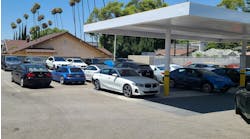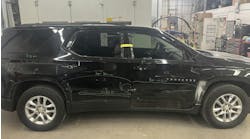Like a manual transmission, it is a constant-mesh gearbox that connects to the engine through a clutch, but there is no clutch pedal. The Powertrain Control Module (PCM) operates the clutch, and the driver can let the PCM do the shifting or the transmission can be shifted manually with the familiar sequential shift lever in the center console or with steering wheel-mounted paddles. In either mode, this transmission is deceptively smooth. In fact, although we noticed something different almost right away, we drove in automatic mode for a whole day before realizing it wasn't a slush box. The secret is a unique three-shaft gearbox design and a new type of clutch made by Borg-Warner.
Downshifting takes about 700 milliseconds and, though noticeable, feels as smooth as a conventional automatic transmission. In fact, the way the computer slips the clutch when the brake pedal is released, making the car creep just like a "normal" automatic transmission, made us think it was a normal automatic. But this transmission has no torque converter, and that's good for a 6 percent improvement in fuel efficiency. In Europe, there are several other self-shifting transmissions without torque converters, and this fuel-saving technology is likely to push the old slush box into automotive history.
The Jetta's new 2.0L FSI engine is another major step towards the future of European automotive technology. Instead of injecting fuel into the port just behind the intake valve, the FSI engine injects fuel directly into the combustion chamber. This provides a huge increase in control over the combustion event itself, and about a 20 percent increase in the amount of power extracted from each gram of fuel burned.
Under the new gas mileage test, this 3,300-pound car achieves a 25/31 city/highway miles per gallon rating, but that's only part of the story. With a low-pressure turbocharger and dual-path intake runners, the torque curve on this engine peaks at 207 ft.-lb. at only 1,800 rpm and stays there all the way up to 4,700 rpm. Two hundred horsepower is generated between 5,500 and 6,000 rpm. This engine is a torque monster that never stops pulling hard, and it's perfectly match to the DSG transmission.
Overall, the GLI is typical of what we've learned to expect from today's German cars, which means it's well balanced and deceptively capable. Driving this car just hard enough be entertaining without getting anywhere near the edge of what it can do means driving at truly imprudent speeds. In cars like the Mini Cooper, back road blasts produce smiles. In this car, it's a far more serious exercise in concentration. And rather than a feeling of accomplishment or even just end-of-the-roller-coaster-ride excitement, the end of this drive produces a desire to do it again, because you know you can do it faster. On the highway, the car feels like it's just hitting its stride at triple-digit speeds. It's as balanced and comfortable at those speeds as others cars are at 75 mph, obviously made for the Autobahn. Erasing speed is just as effortless and un-dramatic, even in an emergency stop situation.
Stellar performance aside, not all is perfect with this car. It shares one offensive feature with all VWs built for the U.S. market in the past decade: the neon-blue instrument panel lights. On a road completely devoid of streetlights - more than half of the road miles in America - there is nothing more distracting and counterproductive for night-time driving than blue lights on the dashboard. While trying to focus on the road ahead, the color constantly draws the eye's attention inside the cabin, and the neon glow can't be dialed low enough to prevent glare when actually looking at the instruments. It's like looking at a television screen in a dark room. Even worse, blue light destroys your night vision even if you're not looking directly at the light source. VW uses this color for instrument lighting in the U.S. market as part of the brand identity that differentiates their cars from others. It certainly is attractive, but it couldn't be more wrong for night driving.
Otherwise the Jetta GLi is every bit as practical as the standard model. It's a five-passenger, four-door sedan, and though classified as a compact, it can indeed hold five adults without requiring too much friendliness in the back seat. And it has one of the biggest trunks in the business.
Up front, the interior feels light and roomy, and the height-adjustable sport seats were pronounced "excellent" by our testers, who come in all shapes and sizes. And while we're certain the Germans still don't understand Americans' insistence on drinking in our cars, Volkswagen has finally equipped the Jetta with useable cup holders.
With a base price just under $25,000, we consider the standard model Jetta a bargain. That price includes a four-year, 50,000-mile warranty (5-year/60,000-mile on the powertrain) and a four-year roadside assistance plan. The car we sampled listed at $29,230, and we feel the added power and handling capabilities are worth the price.




